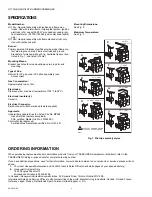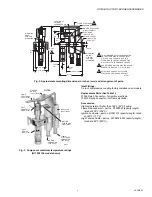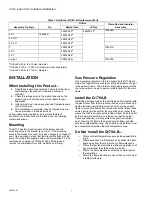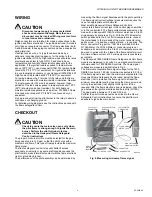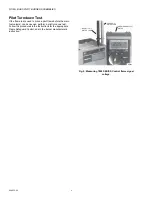
Q179A,B GAS PILOT BURNER ASSEMBLIES
5
60-2032-05
WIRING
CAUTION
Disconnect power supply to prevent electrical
shock and equipment damage. More than one
disconnect may be involved. Wiring must conform
to local codes and ordinances.
Rajah connectors are furnished for making connections to the
ignition and flame electrodes. The ignition electrode (A models
only) takes a receptacle connector. The flame electrode (both
A and B models) takes a plug connector and has a snap-action
spring terminal.
Use high tension wire, of a type found acceptable by a
nationally recognized testing agency, for the wiring to the
ignition electrode (Q179A). High tension wires should be rated
electrically equivalent to type GTO-10 and should have
temperature and humidity characteristics adequate for the
application. If the ignition lead is exposed to temperatures
above 125°F (52°C), use Honeywell R1061012 Ignition Cable
rated at 350°F (177°C) or equivalent. For ignition installations
in a contaminated environment, use Honeywell 32004766-003
High Tension Cable rated at 482°F (250°C) or equivalent.
For wiring between the F terminal of the relay and the flame
electrode, use wire with moisture-resistant insulation. Number
14 single-conductor TW wire is adequate; however, those
portions of the lead wire exposed to temperatures over 125°F
(52°C) should also be heat resistant. For both heat and
moisture-resistant applications, use part no. R1298020 Flame
Rod Lead wire rated at 400°F (204°C) continuous duty or
equivalent.
Run a ground wire from the pilot burner to the relay to assure a
continuous, unchanging ground.
For detailed wiring diagrams, see the Instructions packed with
the flame safeguard control.
CHECKOUT
CAUTION
Check to ensure the main valve opens only when
the pilot flame is strong enough to ignite the main
burner. Perform the pilot turn-down test as
described in the Honeywell Flame Safeguard
Control instructions.
The proper pilot burner orifice must be selected for the gas
being used (natural, LP gas) so that the pilot burns with a
medium hard flame. This type of flame provides the maximum
flame signal.
The flame safeguard control relay will chatter if excess
secondary air velocity or a severe draft condition causes the
pilot flame to make intermittent contact with the flame electrode
(rod) or grounding bracket.
The performance of the pilot assembly can be determined by
measuring the flame signal developed with the pilot operating.
The flame signal (current/voltage) measurement requires the
use of an appropriate volt-ohmmeter.
Most existing Honeywell Flame Safeguard Controls
incorporate a flame current jack in the control plug-in amplifier
or in the control itself. The flame current measurement can be
made with a Honeywell W136A Test Meter, which has a 0 to 25
microampere dc scale (see Fig. 4). With the W136A selector
switch positioned to the 0 to 25 microampere scale, connect
the meter leads to the two ends of the meter connector plug,
positive (red, +) to positive, negative (black, -) to negative. The
Meter Connector Plug part no. 196146 is provided with the
W136A Meter. If a W136A Meter or connector plug is not
available, a dc ammeter with a 0 to 25 microampere scale can
be wired in series with the F lead of the flame detector circuit.
A minimum flame current of 2.0 microamperes is considered
acceptable.
The Honeywell 7800 SERIES Flame Safeguard Control flame
signals are measured in dc volts. A one megohm/volt meter is
recommended for 7800 SERIES controls. The flame signal
voltages are measured as illustrated in Fig. 5.
The minimum acceptable flame signal voltage for the 7800
SERIES controls is 1.25 Vdc (maximum expected is 5.0 Vdc).
If the flame signal is less than the minimum acceptable for the
Honeywell Flame Safeguard Control used, adjust the flame
electrode (rod) to increase the flame signal to at least the
minimum acceptable level by loosening the clamp screw and
turning the electrode (rod) slightly to the right or left as
required. After the flame electrode (rod) is adjusted, check the
gap between the ignition electrode and burner tip (Q179A).
The gap must be between 1/16 and 3/32 inch.
Perform the pilot turndown test as described in the Flame
Safeguard Control Instructions to ensure the pilot flame is
adequate to ignite the main burner.
Fig. 4. Measuring microamp flame signal.
W136A VOLT-
OHMMETER
W136A SELECTOR
SWITCH
196146 METER
CONNECTOR
PLUG
PLUG
FLAME SIGNAL
METER JACK
PLUG-IN FLAME
SIGNAL AMPLIFIER
RED CONNECTOR
BLACK CONNECTOR
BLACK (–) METER LEAD
RED (+)
METER
LEAD
M6532A


